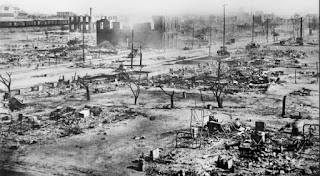Conflict Escalated By Urbanity
After our lecture discussing politics and architecture, especially in recent centuries, it became clear that the presence of an urban fabric (dense or not) only escalated riots. Conflicts and physical battles do sometimes happen in the open field we tend to picture, but it seems that the most typical way of expressing political tension among communities is to occupy a city's streets. Not only do people become victims of political tension and disaster, architecture becomes the victim as well. Why is it that the most "real" atrocities in the US, like the 1921 Tulsa Massacre pictured above, happen where people feel most safe, but are actually vulnerable - inside buildings. Even people who weren't intentionally involved in the riot soon became easy targets and the violence just escalated out of proportion. Even today when there aren't as many violent racial protests, we still see how architecture of the city is targeted as the place which pushes people out of their neighborhoods, causing gentrification. But aren't there still racial issues in rural areas, even though they are less public? Or does the presence of architecture inevitably escalate political issues, no matter how small a protest is at the onset?


Natalie, the way you have framed your question is very interesting to me, because I haven't thought about it in this way before. On one hand, I think the politics of architecture within an urban space have a lot to do with the density of the environment rather than the quantifiable presence of architecture. Though, I can also see that the larger scale and more meticulously planned urban spaces offer more of a platform for politics than rural spaces. I think in the case of protests specifically, it is most common to see this in an urban environment not solely because of the architecture, but because of the presence of government power in these spaces, which notably, is often recognizable due to the style of architecture.
ReplyDeleteI think the point you make about architecture essentially being able to escalate political issues draws back to the idea that cities and politics are inseparable. Architecture is a key functionality of a city. So drawing conclusions from those simple facts, architecture cannot be separate from politics, leaving it in the crossroads whenever political disputes/issues need a place to voice opinions.
ReplyDelete